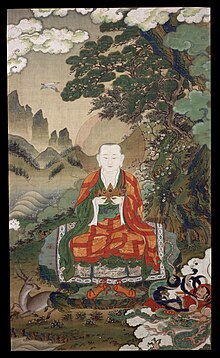Rāhula
Rāhula (T. sgra gcan 'dzin སྒྲ་གཅན་འཛིན་; C. luohouluo 羅睺羅) was the only son of Siddhartha Gautama and his wife, Yaśodharā. He was also one of the Buddha's ten principal disciples.
There are different accounts of when Rāhula was born. Rupert Gethin states:
- The oldest sources say virtually nothing of [Prince Siddhartha’s] life before the time he left home. They indicate that he did indeed have a wife and son, but apart from that all we have is a stock description of a life of luxury enjoyed by the very wealthy and privileged...[1]
Several contemporary scholars report only that Siddhartha had a son prior to his renunciation at the age of 29, when Siddhartha renounced his wordly life to begin living as a wandering ascetic.[2] However, according to later sources from the Pāli tradition, Rāhula was born on the day of Siddhartha's renunciation. Another account from the Mūlasarvāstivāda school (of the Sanskrit tradition) asserts that Rāhula was only conceived on the day of Prince Siddhartha's renunciation, and was born six years later, when Prince Siddhārtha became enlightened as the Buddha.[3]
According to tradition, Siddhartha named his son Rāhula, which means "fetter" or "chain" in Sanskrit, meaning a chain that would keep him bound to his worldly life, and hold him back from following the path of a spiritual seeker.
Sometime after Siddhartha attained enlightenment and became the Buddha, he returned to his childhood home in the city of Kapilavastu and taught the dharma to his family and friends there. At that time, his former wife Yaśodharā told Rāhula to ask his father, now the Buddha, for his "inheritance."
When Rāhula did as he was told, according to the Pāli Vinaya this led to the unfolding of the following sequence of events:
Here, the Buddha is instructing Sāriputta to have Rāhula ordained as a monk. Following the Buddha's instructions, Rāhula was ordained as the first "novice monk" (samanera).
According to the Pāli commentary, this was not quite the inheritance Rāhula’s mother had been intending... From the viewpoint of the Buddha, however, this was the type of inheritance really worth passing on to others: a monastic life wholeheartedly dedicated to progress to awakening. This was his true heritage, and the ensuing events prove him right, as Rāhula did eventually become a fully awakened one himself.[4]
Rahula became a dutiful student, and he eventually became an arhat.
Although early accounts state that Rāhula died before the Buddha did, later tradition has it that Rāhula was one of the disciples that outlived the Buddha, guarding the Buddha's teachings until the rising of the next Buddha. Rāhula is known in Buddhist texts for his eagerness for training, his patience, and his dedication to the monastic code.
Notes
- ↑ Gethin 1998, s.v. Chapter 1, section "The legend of the Buddha".
- ↑ For example: Harvey (2013), p. 17; Smith and Novak (2009), p. 6; Corless (1989), p. 7; Gethin (1998), Chapter 1.
- ↑ This long gestation period was explained by bad karma from previous lives of both Yaśhodharā and of Rāhula himself, although more naturalistic reasons are also given. [check source]
- ↑ 4.0 4.1 The Buddha and His Son, By Bhikkhu Anālayo
Sources
- Bhikkhu Anālayo, The Buddha and His Son
- Corless, Roger J (1989), The Vision of Buddhism, Paragon House
 Gethin, Rupert (1998), Foundations of Buddhism, Oxford University Press
Gethin, Rupert (1998), Foundations of Buddhism, Oxford University Press Harvey, Peter (2013), An Introduction to Buddhism (Second ed.), Cambridge University Press
Harvey, Peter (2013), An Introduction to Buddhism (Second ed.), Cambridge University Press Smith, Huston; Novak, Philip (2009), Buddhism: A Concise Introduction (Kindle ed.), HarperOne
Smith, Huston; Novak, Philip (2009), Buddhism: A Concise Introduction (Kindle ed.), HarperOne
Further reading
- The Buddha and His Teaching, Nārada, Buddhist Missionary Society, Kuala Lumpur, Malaysia, 1988, ISBN 967-9920-44-5
| This article includes content from Rāhula on Wikipedia (view authors). License under CC BY-SA 3.0. |
